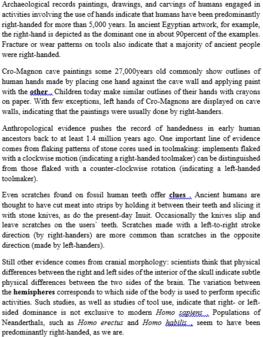Read the following passage and mark the letter A, B, C or D on your answer sheet to indicate the correct answer to each of the questions from 44 to 50.
Insects’ lives are very short and they have many enemies, but they must survive long enough to breed and perpetuate their kind. The less insect-like they look, the better their chance of survival. To look "inedible" by resembling or imitating plants is a deception widely practiced by insects. Mammals rarely use this type of camouflage, but many fish and invertebrates do.
The stick caterpillar is well named. It is hardly distinguishable from a brown or green twig. This caterpillar is quite common and can be found almost anywhere in North America. It is also called "measuring worm" or "inchworm." It walks by arching its body, then stretching out and grasping the branch with its front feet then looping its body again to bring the hind feet forward. When danger threatens, the stick caterpillar stretches its body away from the branch at an angle and remains rigid and still, like a twig, until the danger has passed.
Walking sticks, or stick insects, do not have to assume a rigid, twig-like pose to find protection; they look like inedible twigs in any position. There are many kinds of walking sticks, ranging in size from the few inches of the North American variety to some tropical species that may be over a foot long. When at rest their front legs are stretched out, heightening their camouflage. Some of the tropical species are adorned with spines or ridges, imitating the thorny bushes or trees in which they live.
Leaves also seem to be a favorite object for insects to imitate. Many butterflies can suddenly disappear from view by folding their wings and sitting quietly among the foliage that they resemble.
According to the passage, how does the stick caterpillar make itself look like a twig?
A. By holding its body stiff and motionless
B. By looping itself around a stick
C. By changing the color of its skin
D. By laying its body flat against a branch



Đáp án A
Đề: Theo đoạn văn, con sâu bướm làm thế nào để ngụy trang giống như một cành cây nhỏ?
A. Bằng cách giữ cho cơ thể cứng và bất động
B. Bằng cách quấn vào một cành cây nhỏ
C. Bằng cách thay đổi màu da
D. Bằng cách nằm bẹt trên một cành cây
Thông tin “When danger threatens, …the danger has passed” Ý câu này là chúng trở nên cứng khô và yên ắng như 1 cái cây.